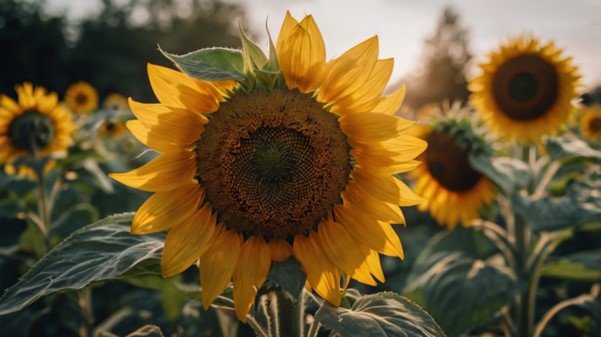Introduction to Sunflower
The sunflower, a beloved ornamental plant, holds significant cultural and symbolic value. Known in English as “Sunflower,” its scientific name is Helianthus annuus. Originating in North America, the sunflower’s native roots trace back to the United States. Over time, this stunning flower has spread across the globe, making sunflower care a widely discussed and essential topic in various regions.
Sunflowers are characterized by their large, round flower heads adorned with bright yellow petals that radiate from a dark central disc, commonly referred to as the disc florets. These disc florets play an essential role in the sunflower’s lifecycle. In many varieties, they transform into edible seeds, widely recognized as sunflower seeds, which are highly valued for their nutritional benefits and culinary uses.
Although the classic sunflower is renowned for its yellow petals, there are other striking varieties with red, orange, and even bi-colored petals, adding to their ornamental appeal. Additionally, sunflowers display remarkable diversity in height. Dwarf species stand at just 0.5 meters, ideal for small gardens or pots, while taller varieties can tower up to 3 to 5 meters, creating a majestic presence in fields and landscapes. These unique traits contribute to the sunflower’s enduring popularity and versatility worldwide.
Growing and Caring Sunflowers in Pots
Sunflowers can add a vibrant and cheerful touch to your home décor as ornamental plants. These bright, eye-catching flowers are perfect for both indoor and outdoor settings. However, caring for sunflowers indoors requires attention to key factors such as watering, sunlight, temperature, soil quality, and pruning. The first step is selecting the right pot with proper drainage to prevent water from accumulating at the bottom, which can damage the plant’s roots. The choice of soil is equally important; a mix of garden soil and compost ensures adequate nutrients for healthy growth. Consistent watering, exposure to sufficient sunlight, maintaining the appropriate temperature, and pruning dried or excess leaves are vital for the sunflower to thrive in a home environment. By following these guidelines, you can enjoy the beauty of sunflowers indoors, whether placed in your living room, balcony, or near a window.
Watering in Pots:
Proper watering is one of the most crucial aspects of growing sunflowers in pots. These plants require soil that remains moist but not overly wet. To achieve this, water the sunflower until the soil is evenly moistened, ensuring that excess water drains out from the bottom of the pot. Allowing water to stagnate at the base can lead to root rot and harm the plant’s health. Establishing a regular watering schedule is recommended, especially during warmer months when the plant’s water needs are higher. Be cautious not to overwater, as this can cause the soil to become waterlogged, which is detrimental to the plant. The goal is to keep the soil consistently moist to a depth that reaches the sunflower’s roots, ensuring healthy growth.
Providing Adequate Light:
Sunflowers are sun-loving plants that require abundant sunlight to thrive. They cannot grow well in low-light environments or as shade-tolerant plants. To meet their lighting needs, place the sunflower pot in a location where it can receive at least 6 to 8 hours of direct sunlight daily. If you’re growing sunflowers indoors, positioning them near large windows that allow ample sunlight is essential. For homes with limited natural light, you might consider using grow lights to supplement the plant’s light requirements. Without sufficient light, the sunflower may struggle to bloom, and its growth can become stunted. Regularly rotating the pot can also ensure even exposure to sunlight, promoting balanced growth and preventing the plant from leaning toward the light source.
Optimal Temperature:
Sunflowers thrive in warm climates and are best suited for temperatures ranging between 20°C and 25°C. This temperature range mimics the conditions of their native environment, allowing the plant to grow robustly. During the warmer months, moving the sunflower pot to an outdoor space such as a balcony, terrace, or garden can benefit the plant by exposing it to natural warmth and sunlight. However, it’s crucial to protect the sunflower from sudden temperature drops or frost, as these conditions can damage the plant. In cooler seasons, keeping the plant indoors near a window with good sunlight ensures it stays within the ideal temperature range. Monitoring the surrounding temperature and making adjustments as needed can significantly improve the sunflower’s overall health and vitality.
suitable soil :
The quality and type of soil play a fundamental role in the successful growth of potted sunflowers. These plants require well-draining soil that prevents water from pooling while retaining enough moisture to support root health. A mix of garden soil enriched with compost is an excellent choice, as it provides the sunflower with essential nutrients for sustained growth. The compost not only improves the soil’s structure but also boosts its fertility, ensuring the sunflower receives a steady supply of nutrients. It’s essential to check the soil’s moisture level regularly; the surface should feel slightly damp but not wet. Adding mulch on top of the soil can help retain moisture and regulate its temperature, creating an optimal environment for the sunflower’s roots.
Pruning Sunflowers

Pruning is a key step in maintaining the health, shape, and aesthetic appeal of ornamental sunflowers. Regularly removing dry, damaged, or excess leaves improves airflow around the plant, reducing the risk of fungal diseases and pests. Pruning also ensures that the plant’s energy is directed toward the growth of healthy leaves, flowers, and seeds. Use sharp, clean gardening shears to carefully trim any unwanted leaves or stems, making precise cuts to avoid damaging the plant. Pruning should be done periodically, especially during the growing season when the plant is actively developing. Additionally, removing spent flowers (deadheading) can encourage the growth of new blooms, keeping the sunflower vibrant and visually appealing for a longer time. By incorporating regular pruning into your care routine, you can ensure the sunflower remains healthy, beautiful, and well-maintained.
Growing Sunflowers in Gardens
Cultivating sunflowers in gardens and fields is an excellent opportunity for farmers and gardening enthusiasts. These plants are highly resilient to varying weather conditions and require minimal care, making them ideal for outdoor cultivation. Sunflowers thrive in sunny environments, as their name suggests, and are capable of enduring a range of climatic conditions. Their adaptability and hardiness make them a popular choice for both small-scale garden projects and large agricultural fields. With proper planting techniques and basic maintenance, sunflowers can flourish and provide stunning visual appeal, as well as practical benefits such as seeds for consumption or oil production.
How to Plant Sunflowers?
Planting sunflowers begins with selecting high-quality seeds and preparing the soil. To ensure optimal growth, sunflowers should be planted in fertile, well-draining soil with a neutral pH level. Begin by loosening the soil and clearing it of weeds or debris. Place the seeds vertically into the ground, spacing them 20 to 30 centimeters apart to allow each plant ample room for growth. It’s best to plant sunflower seeds during spring, after the last frost, to take advantage of the warmer temperatures. Cover the seeds lightly with soil and water them thoroughly to help with germination. With proper sunlight and consistent care, seedlings will begin to sprout within a week or two, marking the start of their growth journey.
One of the most fascinating traits of sunflowers is their heliotropic nature, meaning their flowers turn to face the sun. This movement, known as heliotropism, allows the sunflower to maximize its exposure to sunlight throughout the day, enhancing its photosynthetic efficiency. Young sunflower plants actively track the sun’s path from east to west during the day and reset their position overnight to face the sunrise. This behavior is not only visually captivating but also demonstrates the plant’s remarkable adaptation to its environment. While mature sunflowers eventually settle with their faces towards the east, this unique trait of “sun-following” contributes to their health and productivity, making them a marvel of nature in any garden or field.
Optimal Time for Planting Sunflower Seeds
The timing for planting sunflower seeds largely depends on the season and regional weather conditions. Generally, sunflowers are planted during the spring, as the warming temperatures create ideal conditions for seed germination and growth. In some regions, especially those with milder climates, planting can begin as early as late January or extend into mid-March.
For areas with cooler summers, sunflower planting during the summer months is also feasible, as the plants can thrive in temperate or cold environments. Similarly, in southern or tropical regions with warmer climates, sunflowers can be planted in the fall, benefiting from milder autumn weather.
To ensure successful germination, it’s essential to monitor the soil temperature. Sunflower seeds require a minimum soil temperature of 15°C (59°F) to sprout effectively. Planting in soil colder than this may delay germination or hinder the seeds’ growth. By aligning planting schedules with local climate conditions, gardeners can optimize their sunflower yields and enjoy a vibrant bloom season.
Steps for Planting Sunflower Seeds
If you want to grow sunflowers in your garden and enjoy the beauty of their blooms alongside a harvest of sunflower seeds, following these steps will help you achieve success:
Preparing the Soil for Sunflower Planting:
To successfully grow sunflowers in your garden or field, proper soil preparation is essential. The soil serves as the foundation for healthy growth, providing the necessary nutrients and structure for the plants. Begin by selecting an area that receives full sunlight, as sunflowers thrive in direct sunlight for at least 6–8 hours a day. Use gardening tools such as a rake or hoe to level the ground, remove debris, and break up compacted soil. This ensures better aeration and allows water to drain effectively, preventing root rot. If the soil is too clay-heavy or sandy, consider mixing in compost or organic matter to improve its texture and fertility. Preparing the soil thoroughly creates an optimal environment for sunflower seeds to germinate and grow into robust plants.
Proper Planting Technique for Sunflower Seeds:
Planting sunflower seeds involves careful attention to depth, spacing, and soil coverage. Once the soil is prepared, dig small holes about 3 to 5 centimeters deep for ornamental sunflowers. Place one seed in each hole and cover it gently with soil, ensuring that the seed is secure but not too compacted. Lightly press the soil down to remove air pockets while maintaining its looseness for easy root penetration. After planting, water the soil thoroughly to moisten it, as this aids in germination. However, take care not to overwater, as sunflower seeds can rot in overly wet conditions. For larger sunflower varieties, space the seeds about 30 to 45 centimeters apart to give the plants room to grow. Smaller varieties can be planted closer, at intervals of about 15 to 20 centimeters. Proper spacing prevents overcrowding, allowing each plant to receive sufficient sunlight, nutrients, and air circulation.
Watering and Maintenance After Planting:
Watering plays a crucial role in the successful germination and growth of sunflower seeds. After planting, water the soil generously to ensure moisture reaches the seeds, promoting quicker sprouting. During the initial weeks, monitor the soil’s moisture levels and water consistently to keep it slightly damp. Once the plants begin to grow, reduce the watering frequency but maintain a consistent schedule, especially in dry conditions. Sunflowers are drought-tolerant once established but require regular watering during the early growth stages. Additionally, ensure weeds are removed from the area, as they can compete with sunflowers for nutrients and water. By providing consistent care, you’ll encourage strong root development and healthy plants.
The Importance of Planting Depth and Spacing:
One of the most critical factors in planting sunflowers is maintaining the correct depth and spacing. Planting too deep can delay germination or hinder the seed’s ability to sprout, while planting too shallow can expose the seeds to pests and environmental stress. The recommended planting depth of 3 to 5 centimeters for ornamental sunflowers and 2 to 3 centimeters for oilseed varieties strikes the perfect balance. Additionally, proper spacing is vital to allow each plant access to sufficient sunlight, air circulation, and soil nutrients. Overcrowding can lead to stunted growth and increased susceptibility to disease. By carefully considering these details, you can ensure healthy and vibrant sunflower plants, whether for ornamental purposes or seed production.
Conditions for Growing Sunflower Seeds in Garden

Maintaining sunflower plants in your garden requires suitable conditions to ensure healthy growth and high-quality seeds. Gardeners need to focus on the following factors for successful cultivation:
Sunlight Requirements for Sunflower Growth:
Sunlight is the most critical factor for growing sunflower seed plants successfully. These flowers are called “sunflowers” for a reason—they thrive in direct sunlight. Sunflowers require at least 6 to 8 hours of full sunlight daily to grow strong, develop healthy stems, and produce large, high-quality seeds. When choosing a spot for planting, look for an area in your garden that faces south or receives sunlight throughout the day without obstruction from trees, buildings, or other plants. Without sufficient sunlight, sunflowers may become leggy, with weak stems that are unable to support the flower heads. Additionally, low sunlight exposure can result in smaller flowers and seeds, reducing the overall yield. For gardeners looking to achieve the best results, selecting a sunny and open space is non-negotiable.
Watering Sunflowers:
Watering is another vital component of caring for sunflower plants. Although sunflowers are relatively drought-tolerant compared to many other plants, maintaining the right soil moisture is crucial for healthy growth and seed production. Ideally, sunflower soil should remain moist but not waterlogged. Overwatering can cause root rot, which severely damages the plant and hinders its ability to absorb nutrients. Conversely, insufficient watering can lead to stunted growth, yellowing leaves, and reduced seed yield.
In warmer climates, sunflowers generally need to be watered 8 to 10 times during their growth cycle, while in cooler regions, 4 to 6 watering sessions may suffice. Always monitor the soil moisture by checking the top 2–3 inches of the soil. If it feels dry to the touch, it’s time to water. A drip irrigation system or early-morning hand watering is ideal to ensure consistent soil moisture while minimizing water evaporation. Local climate, soil type, and sunflower variety will affect the watering frequency, so consulting a gardening expert in your area is recommended for optimal results.
Ideal Temperature for Sunflowers:
Sunflowers flourish in warm temperatures and are considered summer plants. The ideal temperature range for their growth is between 20–30°C (68–86°F). These conditions allow the plants to photosynthesize efficiently, leading to robust stems, healthy leaves, and abundant seeds. While sunflowers are resilient and can tolerate cooler temperatures, growth slows significantly if the temperature drops below 15°C (59°F).
During peak summer, sunflowers showcase their maximum growth potential, producing vibrant flowers that are rich in color and seeds. However, in moderate climates with mild winters, it is possible to plant sunflowers in cooler seasons as long as the soil temperature remains above 15°C at the time of sowing. Sudden temperature fluctuations or frost can damage seedlings and affect seed production, so always monitor weather conditions before planting.
Best Soil for Sunflower Cultivation:
The choice of soil plays a significant role in the success of sunflower cultivation. Sunflowers require well-draining soil to prevent waterlogging and root rot. If the soil in your garden is heavy clay or compacted, it is essential to amend it with sand, compost, or other organic materials to improve drainage.
Additionally, sunflowers benefit from soil rich in organic matter. Adding compost, aged manure, or organic fertilizers helps provide essential nutrients and enhances soil structure, promoting healthy root development. Sunflowers also need balanced nutrients for optimal growth. Incorporate fertilizers with an NPK ratio of 10-10-10 or 14-14-14, as these contain equal amounts of nitrogen, phosphorus, and potassium—nutrients critical for leaf development, root growth, and flower formation.
The planting process also affects sunflower growth. Ensure the soil is well-tilled, loose, and free of debris before planting seeds. This allows roots to penetrate easily and access nutrients more effectively. Maintaining a consistent pH level of 6.0 to 7.5 is also important, as extremely acidic or alkaline soils can interfere with nutrient absorption.
Final Tips for Watering and Care:
Growing sunflowers successfully requires paying attention to multiple factors simultaneously. Consistent sunlight exposure, adequate watering, warm temperatures, and nutrient-rich soil create the perfect conditions for vibrant flowers and high-quality seeds. Regularly monitor soil conditions, check for pests or diseases, and adapt your care routine based on local weather patterns. By following these detailed guidelines, gardeners can enjoy beautiful sunflowers while benefiting from a productive harvest of nutritious seeds.











